Introduction to Light and Color
Almost everything you ever wanted to know about color can be understood by understanding the wave-like nature of light.

Light is a type of electromagnetic wave, just like the radio waves emitted by a cell phone, or the microwaves inside a microwave oven. The only difference between these different electromagnetic waves, is the size (or wavelength) of the waves.
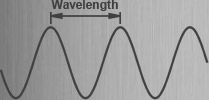
The electromagnetic waves inside a microwave oven are about 12cm in size. Visible light waves, those waves that the human eye can see, are much much smaller. They have a wavelength of less than one thousandth of a millimeter. More specifically, the electromagnetic waves from 400nm to 700nm in size (and everything in-between), are the only electromagnetic waves that are visible to the human eye. These electromagnetic waves are called “light” or “light waves”. Electromagnetic waves that are smaller than 400nm or larger than 700nm are not visible to the human eye, and that is why you cannot see the microwaves inside a microwave oven or the radio waves emitted from a cellphone.
The difference in size between different electromagnetic waves has a great affect on what happens to the waves when they hit physical objects. For example, the door on a microwave oven has many small holes. You can see inside the oven because the light waves, which are very small, can easily pass through the holes. The much larger microwaves, on the other hand, are too big to pass though the holes, and cannot escape the oven. They just bounce around inside the oven until they hit some food where they get absorbed and turned into heat.
Light sources, like the sun or a light bulb, radiate electromagnetic waves comprising of many different wavelengths. Generally, when all the different wavelengths from 400nm to 700nm in size are present, in roughly equal proportions, we perceive the light to be white or colorless.
When the light waves from a light source hit an object, different things happen to the different wavelengths of light. The molecules that the object is made of interact differently with different wavelengths, just like the door on the microwave oven that reflects the large microwaves, but lets the small light waves through. In general, when light waves hit an object, one or more of the following things can happen:
- The light waves can be reflected, ie bounced off the object in a mirror-like fashion. This is called specular reflection.

- The light waves can pass though the object. Think of a pane of glass.

- The light waves can be scattered in all directions. We refer to this as diffuse reflection. A sheet of white paper is a good example of an object that diffuses light.

- The light waves can be absorbed, and converted to heat. If you place a white object and a black object in the sun, the black object will feel hotter. The reason for this is that the black object absorbs the light from the sun, turning it into heat, while the white object reflects the light in all directions, and stays cool.

Most real world objects cause not just one, but a combination of the above effects. Some wavelengths are absorbed while others are reflected, and when this happens an object will appear to have color.
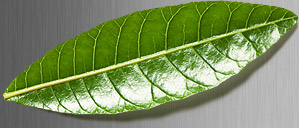
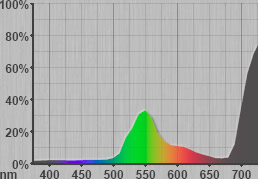
The leaf below, for example, exhibits specular reflection, diffuse reflection and absorption. The bright area visible on the lower half is specular reflection, typical of glossy surfaces. The rest of the leaf appears green, which is the result of some wavelengths being absorbed and some wavelengths begin reflected. To understand why it appears green specifically, we need to take a closer look at how the different wavelengths of light are reflected by this leaf.
The graph on the right is from a spectrophotometer, an instrument that was used to measure the diffuse reflection of this leaf at various wavelengths. The vertical axis shows the percentage of diffuse reflection. The horizontal axis shows the wavelength.
In the middle of the graph, at 550nm, there is a peak*. It shows that 35% of waves having a wavelength of 550nm are reflected. Waves shorter than 550nm and waves longer than 550nm are almost completed absorbed (very little is reflected). This partial reflection of light, that varies with different wavelengths of light, is directly due to the interaction of the light waves with the chlorophyll molecules contained within the cells of the leaf. The chlorophyll molecules partially reflect 550nm waves (35% of all waves having a wavelength of 550nm are reflected), and almost completely absorb other wavelengths.
*There is another peak at 725nm, where the leaf reflects about 70%. This area of the spectrum (>700nm) is called the infrared area and is mostly invisible to the human eye. So even though the chlorophyll molecules reflect infrared waves very well, it does not affect our perception of light and color, and can be ignored.
To recap: Light waves radiating from a light source generally consists of all the different wavelengths. When these waves hit an object some wavelengths will be absorbed, while others will be reflected. In the case of this particular leaf, it is mostly the waves having a wavelength of 550nm that gets reflected and reaches the eye. To understand why these 550nm waves are perceived as the color green, we need to briefly look at how the human eye works.
Inside the eye we have light sensitive rods and cones. The rods are only used when it is fairly dark and do not play a role in color vision. The cones are what make color vision possible. There are three different types of cones, called S, M and L cones. The S cones are sensitive to light with a wavelength roughly from 400nm to 500nm, the M cones 450nm to 650nm, and the L cones 500nm to 700nm. When looking at this leaf, the M cone types will receive more light than the other cone types because of the peak at 550nm that is being reflected from the leaf. This is interpreted by our brain as the color “green”.
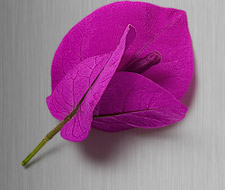
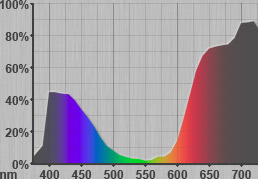
Most objects reflect at least a little bit across the full spectrum. Some objects reflect a spectrum with multiple wavelength peaks or a broad range of wavelengths. Typically all three cone types always receive some light. What matters is the proportions. For example, the color of the Bougainvillea flower shown here will result in the L cone receiving the most light (from the large reflection peak at 700nm), followed by the S cone (from the reflection peak at 400nm). The M cone will receive the least amount of light because of the absorption (very low reflection) at 550nm. The light reflected by this flower, with these particular proportions (L cones receiving the most light, S cones the second most, and M cones the least), is interpreted by out brain as the color “purple”.
In this way, by comparing the intensity of light received by the three different cone types, we can perceive color. In addition, “light” colors are those colors that reflect more light overall. “Dark” colors are those that reflect less. An object that we perceive to be white is simply one that reflects all visible wavelengths. A black object is one that absorbs all visible wavelengths. It is important to note that color exists only in our minds. Light by itself has no color, only different wavelengths. When we say an object has some or other color, what we are really saying is that the object reflects some wavelengths of light while absorbing others.
Summary
Light is a type of electromagnetic wave. Most electromagnetic waves are invisible and require special equipment to detect, but those with a wavelength between 400nm and 700nm can be seen by the human eye. These electromagnetic waves are called light. Different objects reflect or absorb different wavelengths of light. The specific wavelengths of the light that are reflected by an object determines its color.